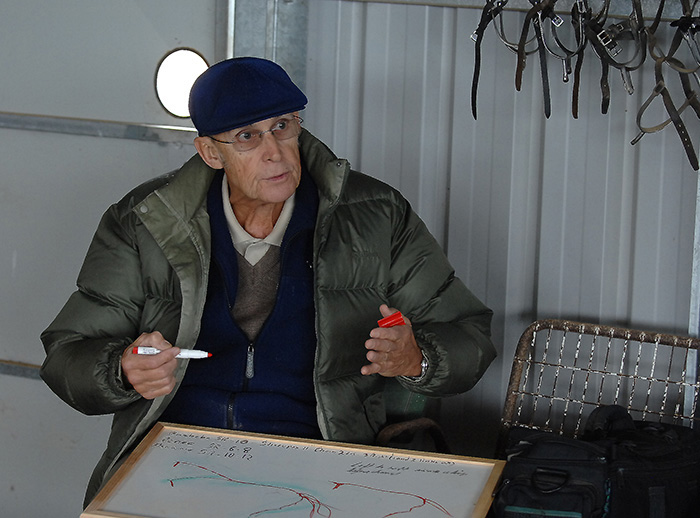
Major D. Miguel de Lancastre e Tavora (Abrantes)
1943 – 2017
It is six years since my dear friend Miguel Tavora died. Luckily in the last weeks of his life, when he knew death was imminent, we had a chance to make our last farewells. He died with the dignity with which he lived.
There is not a day that goes by that I do not miss him.
He was one of the few people in the world with whom I could discuss equitation and the writings of the great equestrian theorists, but I miss him far more for his warmth, and his humour. Still I was lucky, I got to ride in many of his lessons, indeed one day he put me on his Grand Prix horse, Rubens, to let me experience the complexity of one times changes. I was lucky enough to travel in his native Portugal, with Miguel and his wife, Di, and spend many happy hours at their property at Kurrajong, watching Miguel train his pupils.
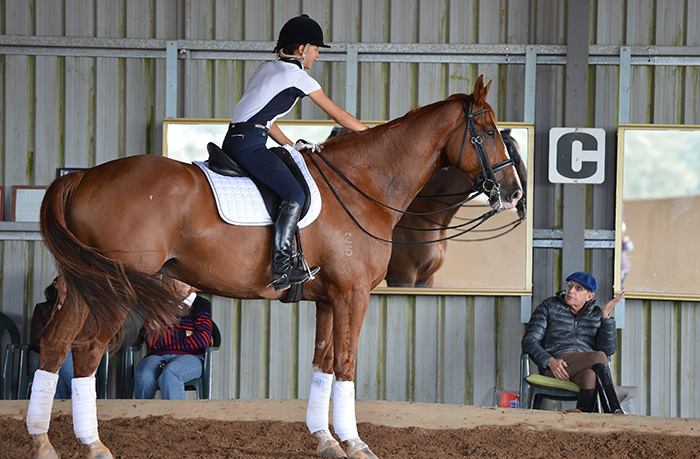
Watching Miguel in his role as teacher, particularly with the mega-talented Grace Kay in the arena, was like watching a particularly sublime pas de deux, not only were the horse and rider in such absolute and sympathetic sync, but Miguel and Grace had an almost telepathic feel for the next move in their gymnastic sequence…
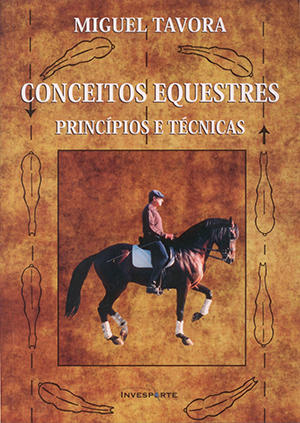
The last months before his death were dominated by his book. Miguel had already published it in Portuguese, but asked me to help with the English language version. In truth Miguel was remarkably articulate in a number of languages and his English was extremely good. Still I hope that I helped with some of the nuances, the fine details – seemingly Miguel approved, since every couple of weeks, he would ring me: Crees, I have added one little chapter to my book, do you have time to look at it? And of course, my answer was always, of course.
As I noted in the forward to the book, when I started reading it, I thought it just a bit too austere. It was I guess a bit like his teaching style – Miguel was not the most popular dressage trainer in Australia even though he was, in my opinion, the best, but he did not suffer fools gladly, and nor did he flatter or deceive to make customers happy. But as with his teaching, if you took the time to sit and watch, the pattern would emerge, so with the book, it moves with a clarity and relentless logic towards an equestrian philosophy that combines the best of the Iberian, French and German thinking.
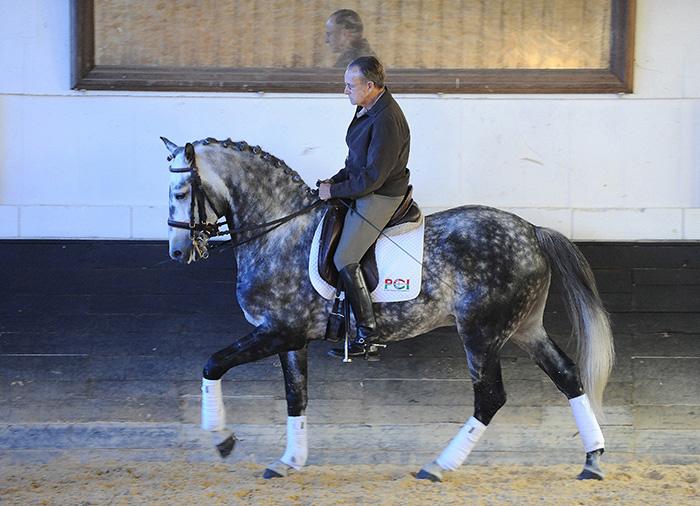
Miguel Tavora riding a Lusitano belonging to the Caetano family
There was for a long time, a simple minded attempt to set the Romantic (French, Spanish, Portuguese) dressage tradition, against the demanding, forceful Germanic teachings. It was always nonsense, Miguel, like his teacher, Nuno Oliveira, was forever stressing the importance of that great theorist of modern dressage, Steinbrecht.
Central to Miguel’s philosophy is a clear awareness of the nature of the horse, and he stresses that a horse does not ‘love’ his work, but that it is the job of the rider to be aware of the horse’s physical and mental condition, so that the work he is asked to do is not beyond his capabilities:
“The instinct of self-preservation makes the horse seek comfort. If the horse finds what we ask him to do difficult, this instinct will tell him not to do it or to do it in a way that he finds easier. His way may not be the way we intend him to do it. Thus, training a horse is a matter of being able to make everything we ask him to do, easy. Only then will a horse be able to understand what we are asking of him. For this reason, understanding in equitation means becoming easy. We will only be able to achieve this by gradually developing the muscles, suppleness, flexibility and general athletic capability of the horse. This is one of the most important principles in equitation.”
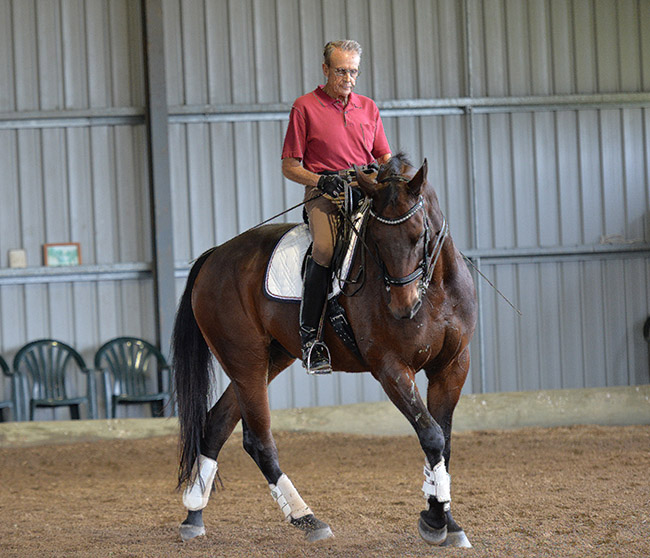
Indeed it might be claimed it is the most important, because it is this awareness of the way in which the training must progress according to the capacity of the horse at that particular time and at that stage in its development that sets dressage apart from other systems of training no matter how sophisticated they may be. The better exponents of Western training have a well thought out set of techniques, yet when we look at the tests presented to the Western Reining horse we see that they are required to do the same movements as a three-year-old (sometimes two-year-old!), as they are as mature horse – the same double spins, the same sliding stops – there is no awareness of the crucial importance of the gradual development of the horse’s body by means of gymnastic exercises.
We can find examples of a similar lack of awareness even within the ranks of some who are called dressage masters. I guess most of those who nod approvingly in the direction of James Fillis have never actually read his book, where right from the start, in the first lesson, indeed the first ride, the horse is asked for a high degree of collection and a school trot…
As Miguel puts it:
“The horse must always feel comfortable in all equestrian activities. This is how we show him our love and respect. We are very lucky because the correct classical methods of working a horse make the horse feel most comfortable in the long run, even if at first, the new exercises may be a little difficult for him.”
Don’t get the impression that Miguel was another of those equestrian ‘experts’ who blather on forever in the realm of warm and fuzzy platitudes, the rest of the book rigorously lives up to its subtitle: A blueprint for the serious rider.
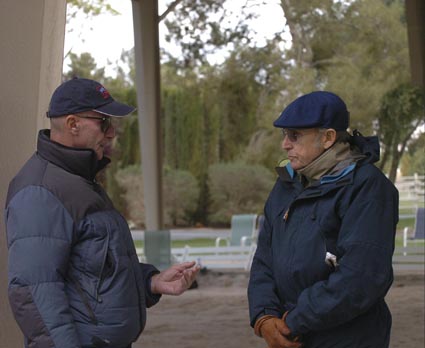
Two great minds meet – George Morris and Miguel Tavora
For all Miguel appreciates the modern German training scale, his reading of that scale is infused with his knowledge of the great masters of French equitation, balancing the rhythm, losgelassenheit, contact, schwüng, straightness and collection of the German canon, with the French master, L’Hotte’s Calm, Forward, Straight and Light. Pause and think, are they the same or different, or different but the same…?
Miguel was also able to appreciate the insight offered by Baucher without succumbing to his siren song which has lead so much of French equitation down a rarified path to nowhere over the past century or so – a dead end that is only now being rectified with the wisdom of one of the most sophisticated exponents of the German principles, the French team trainer, Jean Bemelmans.
Miguel quotes Baucher’s disciple, Faverot de Kerbach:
The ease with which the rider modifies the distribution of weight over the four legs to produce different positions, indicates the degree of balance of the horse.
It was this attention to balance that set Miguel off from many of the less subtle trainers, while they might have felt impelled to concentrate on impulsion, or for that matter collection, Miguel was lightening fast to draw his pupil’s attention to the slightest loss of balance, and the ones who had paid attention, would have half a dozen exercises they could use to regain that balance.
Again we come back to the central concept of ease but at the same time not falling into the trap of emphasizing balance to the neglect of impulsion:
“Classic or academic equitation is always the result of the correct combination of balance and impulsion, which produces collection. We must always have the mental and physical development of the horse in mind. When the horse is comfortable in his activities, we achieve the balance and impulsion needed to reach the final goal of the training scale – collection. This is done only through correct, gradual, progressive, logical and systematic gymnastic work.”
And balance and impulsion are the key to the most vexed question of equitation – contact:
“Incorrect contact is easy. Any jockey who pulls on the reins while galloping establishes a contact by the principle of physics that states that ‘any action provokes an equal and opposite reaction’. If the rider establishes contact by ‘riding into the bit’ or tries to make the horse ‘seek the contact’, he will achieve the same result as the jockey. He will have a horse that pulls on the bit and he will have to pull back.”
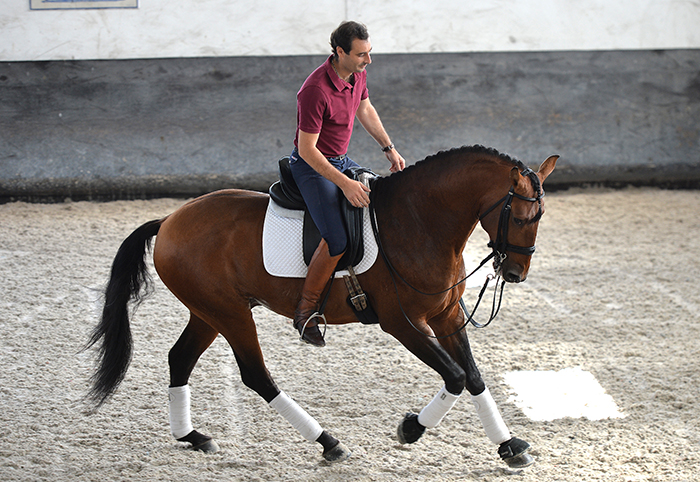
Miguel took us to visit Rodrigo Torres when we visited Portugal. Rodrigo demonstrates balance for us…
“We must understand that correct contact is always a result of proper balance and impulsion. Correct contact in academic equitation can never be sought directly.”
It is the equitation equivalent of the sound of one hand clapping, contact can only be achieved by not trying to achieve contact but by creating the qualities that produce contact, and again it comes down to balance:
“Lightness is the result of flexibility in balance – a horse that is able to control his body in all paces, positions and movements. Because of this flexibility in balance, he can obey the aids of his rider immediately and correctly with ease and without resistance. The light horse feels confident and comfortable in everything he does. True submission is the result of lightness, and we cannot have voluntary submission (its true meaning in classical equitation) without lightness.”
And all this adds up to self-carriage:
“The rider thinks, the horse executes.”
“As the term implies, self-carriage means that the horse carries himself in the best and most appropriate manner for the movement or activity to be executed, without the need of constant help from his rider.”
“Self-carriage is the result of the correct combination of balance and impulsion and is also the proof of it. The horse’s body must be cultivated for the suppleness and strength he will need to find it easy to move with balance and impulsion.”
I know there are lots of books that talk grandiloquently about these concepts, but how do you do it? This is where Miguel’s book is the exception to the rule. Here you will find the recipes, step-by-step, clearly illustrated, to achieve this lofty end result. We can start with the start, with the asprin of equitation, the shoulder-in. One of Miguel’s signature exercises, one that began any session – and one that could be re-introduced at any time the balance seemed endangered – was the small circle around the inside leg:
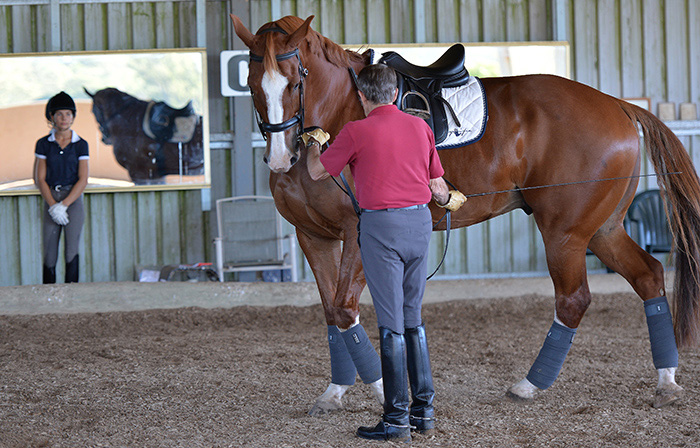
Here it is:
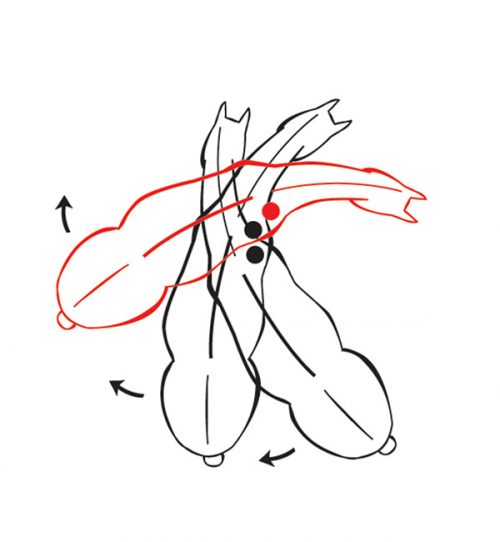
and observe how sweetly it is transformed to that all-important shoulder-in:
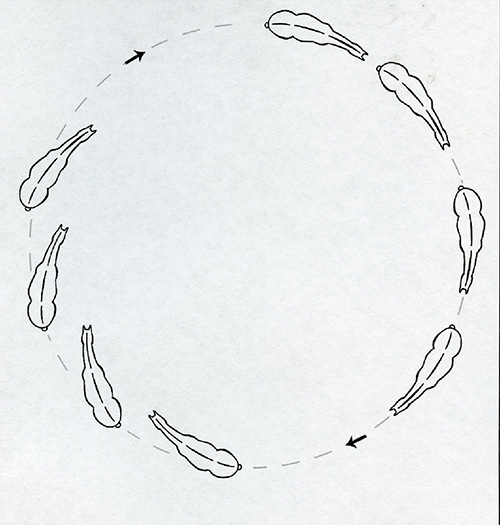
Or we leap up the training scale to the teaching of piaffe.
This is the first step of our recipe:

And the icing on the cake…
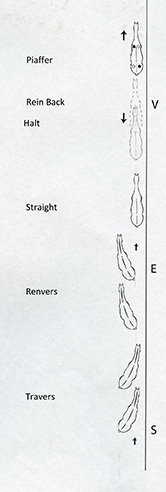
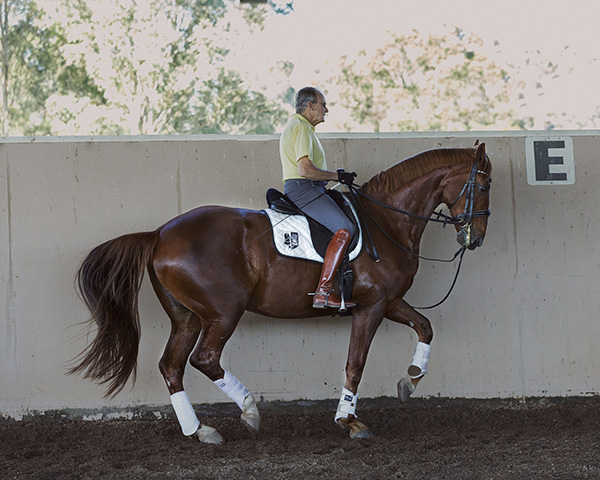
Miguel and the young mare Boronia in piaffe
But no matter how advanced the work becomes, those fundamental qualities must never be lost. Here are Miguel’s notes in training the Piaffer and Passage:
* In all the work, the horse must be light in the contact and responsive to the actions of the legs of the rider. Every time the rider feels the horse losing the lightness, he must halt, regain the lightness and start again.
* The straightness must always be maintained.
* The regularity of the strides always takes priority over elevation and expression. Elevation and expression can only be developed when the regularity is well established. Most problems occur in the piaffer and the passage because the rider starts trying to achieve the elevation or expression before having established the regularity of the strides. In these cases, the work was not confirmed and the horse was lacking balance or impulsion or both.
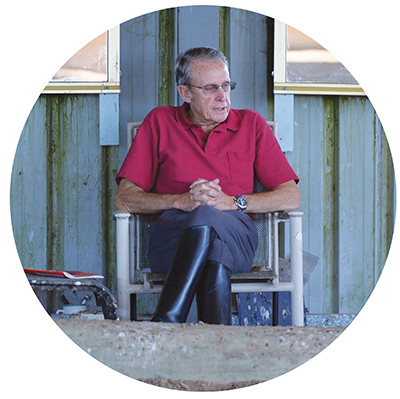
Writing this appreciation I remember yet again how much I miss the man, how many times I would have stopped typing and picked up the phone to clarify a point, or check an interpretation, alas, that is not possible, how lucky we are then to have the thoughts available to us in such an elegant form, so lucky that the insights of this great horsemen were not lost with his passing. Buy it, read it, read it again, then get out and do it, then read it again, for as Miguel notes in the final sentence:
We cannot understand equestrian theory without practice, but practice without theory does not have any value.
Thank you my friend for leaving us this treasure of a book… Christopher Hector

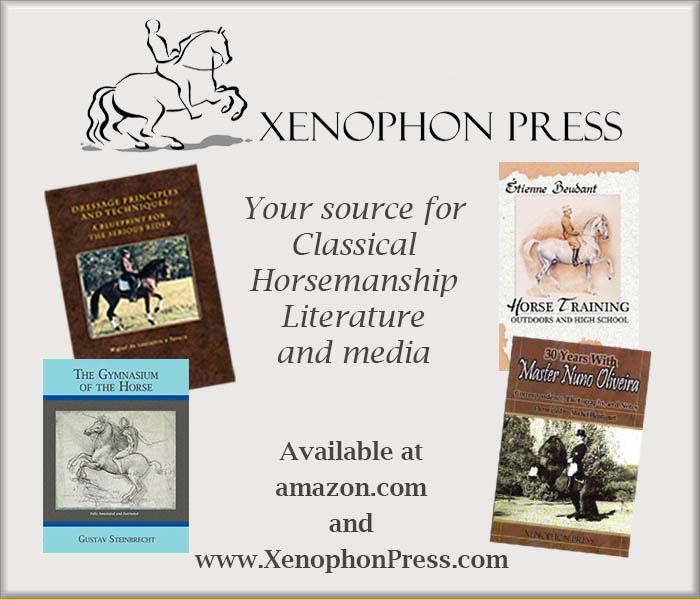
Visit Xenophon Now
There is a whole library of articles on, and by, Miguel, waiting for you on the THM website, just click this link to find them


Yes, this is softness and natural impulsion, the true equitation.
Beautifully said Chris. I miss Miguel every day as well. But his legacy lives on. This book has become my “bible”. I still train my horses and students along Miguel’s guidelines and teachings. It was a privilege to have been one of his students.
Megan Joerg.
Fabulous book. Well done Chris for helping the Master, Miguel, to produce his wonderful book in English.
This is lovely Chris, I am looking forward to reading the book. I still hear him in my head, on every horse. He made us think carefully and kindly of our horse so the progress is always easy. I miss him so much, and I am very grateful to Dianne, that this book is published in English. I will hold on to the principles he taught for the rest of my life.
A wonderful tribute Chris Hector. Miguel always spoke fondly of you. I was privileged to work closely with Miguel producing diagrams of his excercises for this book. This enablied me to really concrete my understanding of movements I had ridden under Miguels guidance for 35 years. I miss him dearly, but he will be with me always with the training of my horses, and his voice lives on within the pages of his book. ❤️